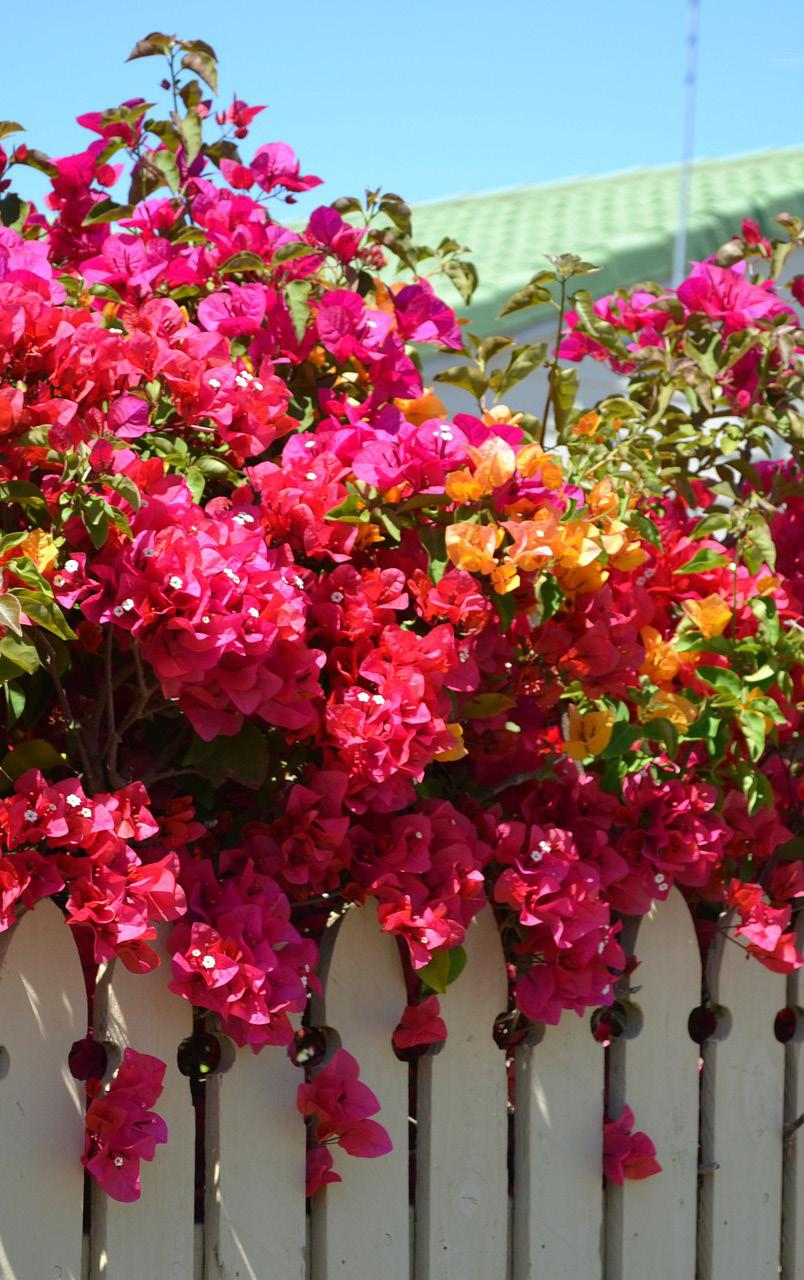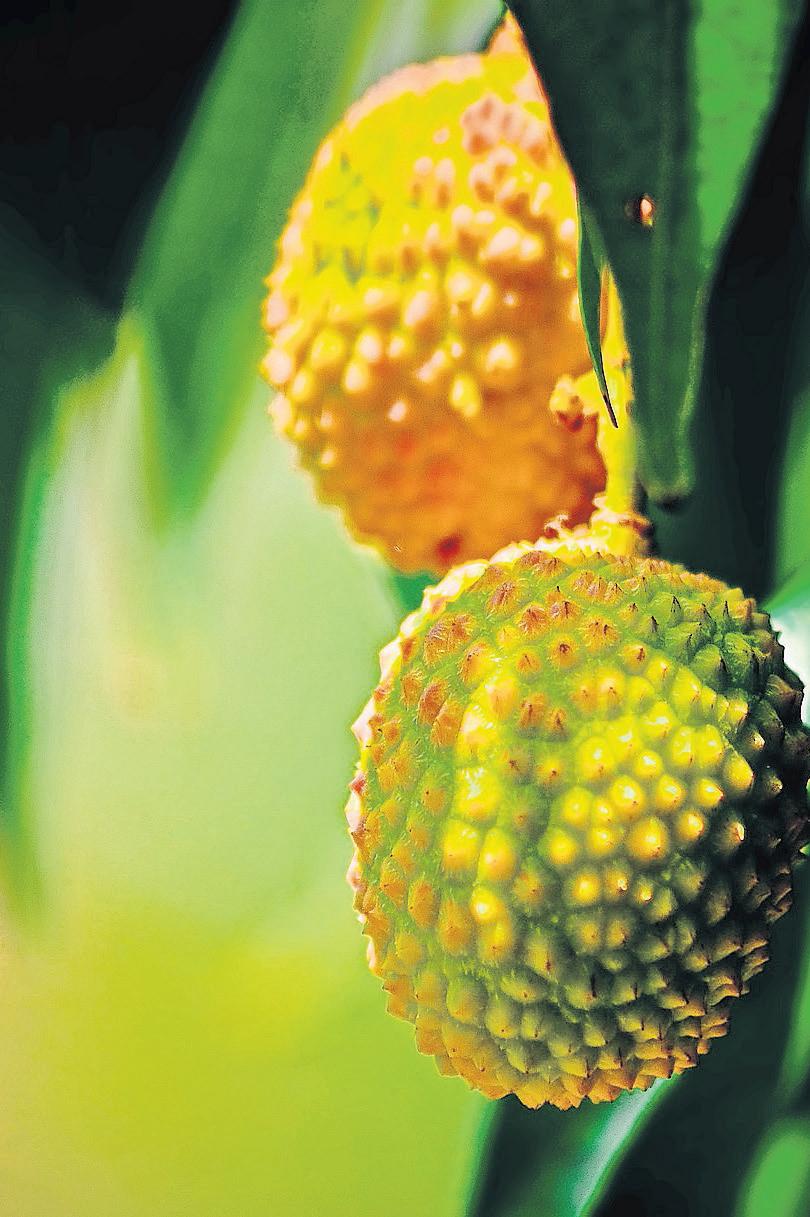
11 minute read
Gardening
from 07302021 WEEKEND
by tribune242
16 | The Tribune | Weekend 16 | The Tribune | WeekendFriday, August 7, 2020
gardening gardening gardening Maintenance and All about the Pruning for preparation lychee tree tree strength
Advertisement
I’VE just arrived back on the island after a few weeks away, and I go straight back to the maintenance that the summer months make necessary.
Most things are growing like weeds, and the weeds are growing like they’re some super powered green monster designed to cover the earth with their offspring. How sharp are your clippers and machetes?
Most weed killers are so toxic to anything living that I don’t like to promote their use and wise application is helpful to the living world. Spraying for weeds can be the most efficient management method in some situations but I always leave weed killers to be used only as a last resort.
The vegetable garden has gone kaput while I was away, and so what do we do now? For us, we still have several weeks of maintenance, potting up, fertilizing, and pruning year-round material to do before we get to thinking about reseeding and regrowing veggies. We are removing anything left over and not producing in the veggie beds, except for herbs and onions, okra, peppers, sweet potato, cassava, pigeon peas, wild cherry tomatoes, and eggplant. The one thing that stands out for me is a grafted tomato that is going strong and resetting fruit, even now in the middle of summer which is both impressive and surprising to me.
It is a perfect time of year to prune bougainvillea, and for those plants already established, we prune them hard during the summer by cutting them back to wood so that the size remains controllable where that is desired. They regrow their foliage so quickly that it is almost impossible to cut them too much. Most any shrub can be pruned back quite hard at this time, Hibiscus, green island ficus, etcetera, to control their size.
Garden plants are using up a lot of the available nutrients in the soils during this, their peak growing season. If anything is going pale or yellowing, take a piece of a branch or stem with leaves into your favorite garden center for recommendations for nutrients to ensure proper growth and appearance in some of the more nutrient demanding plants (lady palms, hibiscus, gardenia, etcetera).
Some slower growing materials (lady palms, gardenia) are difficult to green up again once they get deficient, and regular maintenance is recommended in the form of nutrient applications before the problem shows itself.
For all the lawn lovers out there, how sharp are the blades on your lawn mower? To keep the lawn thick and lush, regular mowing is needed and the blades get dull over time. So rather than cutting the blades of grass, the lawn mower blades end up tearing them, and this can create a bit of a raggedy looking lawn. An annual blade sharpening will help to keep a tidy and healthy lawn. There are machine shops and lawn mower maintenance businesses that will get the job done right, if you don’t want to break out the file yourself.
Lawns will show great results if they are fertilized in August. I always recommend a fertilizer with a pre-emergent herbicide to prevent weeds before they take hold. Conversely, if your lawn is already weed infested, a post-emergent herbicide and fertilizer is recommended to apply in the next few weeks. Buy or rent a spreader for best results. Hand application is inconsistent and not uniform, and by using a spreader (rotary or drop spreader, depending upon the size and design of your lawn area), more productive and uniform results can be achieved. So, it seems that there is a lot to do out there. Keep at it, even through the heat!
The veggie growing season will be upon us in a blink of an eye. It may even be beneficial to start amending your veggie garden area in
GOOD day, gardeners! Time flies, yes? Time is subjective also. Had I planted a lychee (Litchi chinensis Sonn/Nephelium litchi Cambess) from seed 15 or 20 years ago, I might have a few lychee fruit from that tree by now to enjoy. Until then, they are a demanding shade tree at best.
Not particularly fast growing, the lychee takes its time to mature, and this is the reason that air layering exists. Commercially, they are layered for propagation as they grow a strong enough rootstock by that method and remain true to type. It is said that the choicest varieties have greater variation in offspring quality, and that the seed of the lychee is only viable for four to five days, so it is not something that is recommended to buy from unknown sources over the internet. I do not have 15 or 20 years to wait on those fruit, if you have got kids, well, eventually they may thank you for planting some of them. It certainly does not hurt to plant them anyway; every tree benefits every one of us.
If you are seeking lychee fruit in a faster time frame though, and if you have space for only a tree or two especially, do not even bother with seeding them. Layer from a friend or neighbour’s tree or buy from a reputable supplier. Now, don’t get upset with me if you’ve just seeded some and you’ve got the space to plant them and let them grow, grow them!
Lychee trees are not very salt tolerant or wind tolerant and they are best planted in a protected location with full to part shade, preferably in a relatively deep soil base. They are preparation for seeding or planting a strong tree with a slow to medium in another several weeks. Collect and growth rate and they have a relatively turn in some seaweed into your veg thick foliage to make a medium to garden soils. It will benefit the soils heavy low hanging shade, but they are highly susceptible to nutrient deficiencies, OK? The history of the distribution of the lychee is complex and quite fascinating if you are up for a follow up read, cite the first referand by the time you get to replanting in September or October, the seaweed will have had a chance to breakdown and will have started giving back to the soils. As always, I ence noted below. wish you happy gardening!
The soils in our archipelago are (generally and variably) alkaline and lychee’s native range is an acidic base where they can thrive. At the Redlands in South Florida there are lychee groves that are highly productive in the good years (they are apparently quite cyclical), and when I was roaming the area a few weeks ago the trees were loaded, but the fruiting season in that location is finished now. The current issue now for lychee in the region (other than too much heat and humidity) is a mite that is affecting groves. The mite at issue is called the Erinose mite. It creates galls on the leaf and is supposedly quite difficult to eradicate. It is microscopic and too small to see by eye, but galls on the leaf of lychee will confirm the presence of them. To the best of my knowledge and research, we do not yet have the Erionose mite present in the Bahamas. Lychee are grown successfully to our north and south, and there are large fruiting trees right here in New Providence. It is possible to grow a fruiting lychee tree, but as usual, it is recommended to either source from a reputable supplier, or to air layer a new tree from an existing fruiting tree. The fruits can be quite variable in size and texture, as well as in the time of year that they fruit in. As per the initial reference noted below, there are many varieties that have been prized in its native ranges in China, but they are limited as to what is available commercially even though they are grown through Asia, Southern Africa, and in the Americas and have been being transported for hundreds of years. The lychee has a grand history, that again I suggest taking a few minutes to read up on if you are interested. To conclude, plant lychee in a protected
NOW that we have had the first storm of the season pass through, pruning is again on my to-do list in the garden. We had some small trees get blown down in that (fortunately) weak tropical system Isaias, and it reminds me that tree pruning needs to continue. It is also a great time to prune hedges, shrubs, perennials, and anything branching. Much of the garden should be growing quite quickly at this time of year. If your garden is not growing quickly it may be worth doing some fertilizing to green and boost branching, flowering and root development. For those of us that are relegated to our own property to help stem the spread of COVID-19, get your clippers, hedge shears, saws or scissors out and get trimming!
It’s important to do a few things correctly when it comes to pruning larger trees, and even medium and small trees will benefit from these steps. Primarily, it is all about the branching angles. Wider angles make for stronger branching. Tighter angles make for weak branching. Early corrective pruning when the tree is young is the efficient way to location away from wind and salt prevent much heavier work in the spray. Choose an area with deep soils future. Try to encourage the crotch if possible and give them ample supangles on branches to be at least plemental nutrients throughout the 45 degrees from the upright, main year. As with anything in our region trunk, up to 90 degrees. This is there will be pest problems, but I especially beneficial to create wind have not noticed anything to attack tolerance (hurricane alley….!), and the lychee to the point where drasparticularly with fruit trees that tic remediation is necessary. Keep an bear more weight than the average non-fruiting tree. Allowing wind to easily move through a tree is always less work that cleaning up the mess left from a tree that the wind moved rather than moved through. eye on your young trees and try to keep the leaf a medium green colour, even though some colour variation exists between the named varieties. Happy gardening, and as always, good luck!
Always remove dead wood from trees and shrubs. Dead wood adds unnecessary weight, wind resistance and it can harbour pests and disease. Termites enjoy dead wood as well! Where to cut is as important as how to cut. For trees, the final cut after branch removal should be made at the branch collar so that the tree can heal properly without allowing for pests or disease to intrude. Here are some helpful pointers for pruning: • Dead, dying or unsightly twigs and branches. • Sprouts growing near the base of the trunk. • Crossed branches and branches growing toward the centre of the tree. • Narrow crotches. If it is possible to do so without ruining the appearance of the tree, remove one of the members forming the weak crotch. This helps to prevent future storm damage. • Multiple leaders. If more than one leader develops on a tree that normally has a single stem, cut out all but one to encourage the tree to develop its normal shape. • Remove branches that may develop into potential hazards such as low-hanging branches that interfere with traffic and weakened or dead branches that may break. • Single branches other than the leader sometimes develop faster than the rest of the tree. They need to be cut back to allow the tree to develop its normal shape. Other than pruning, it is still a very active season for garden pests. If you’re practicing a good IPM (integrated pest management) programme, hopefully all of your garden is not negatively affected by them at this point. Continue to monitor for crawling and flying insects and pests. As earlier mentioned, it may be time to get some plant nutrients down to support stronger pest resistance, wind resistance, branching, rooting, flowering, and fruiting except if your fruit tree has fruit on it now. If your tree has fruit left on it after the wind blew through, wait until a few weeks after the fruiting has finished to begin adding nutrients. Fruiting trees need quite a different fertilizing routine than non-fruiting trees. Native trees typically do not need to be fertilized, except maybe when young to promote stronger and faster

By ADAM BOORMAN • Tribune Features Reporter • acadet@tribunemedia.net
establishment. If there are no native trees in your yard, please consider planting one or more, if you have the space. If you do not have space for a native tree or more, native shrubs will encourage balance in the garden just as well as native trees.
I wish you all of the best during these difficult and trying times. I encourage you to get into the garden, get to pruning and trimming, get to fertilizing where necessary, and get to composting. Please, plant a native tree or shrub. Pay attention to trees when they are young to avoid problems with them in the future. As always, I wish you happy gardening!

Adam Boorman
An example of a weak branch angle susceptible to splitting. This type of branch should be removed.
SLOW to grow and a demanding tree, you will have earned the fruits of your success if you cultivate lychee.
NOW is the perfect time to prune your bougainvillea.
• Adam Boorman is the nursery manager at the Fox Hill Nursery. You • Adam Boorman is the nursery manager at the Fox Hill Nursery. You can contact him with any questions can contact him with any questions you may have, or topics you would like to see discussed, at gardening242@gmail.com. • Adam Boorman is the nursery manager at the Fox Hill Nursery. You can contact him with any questions you may have, or topics you would you may have, or topics you would like to see discussed, at like to see discussed, at gardening242@gmail.com. gardening242@gmail.com.







